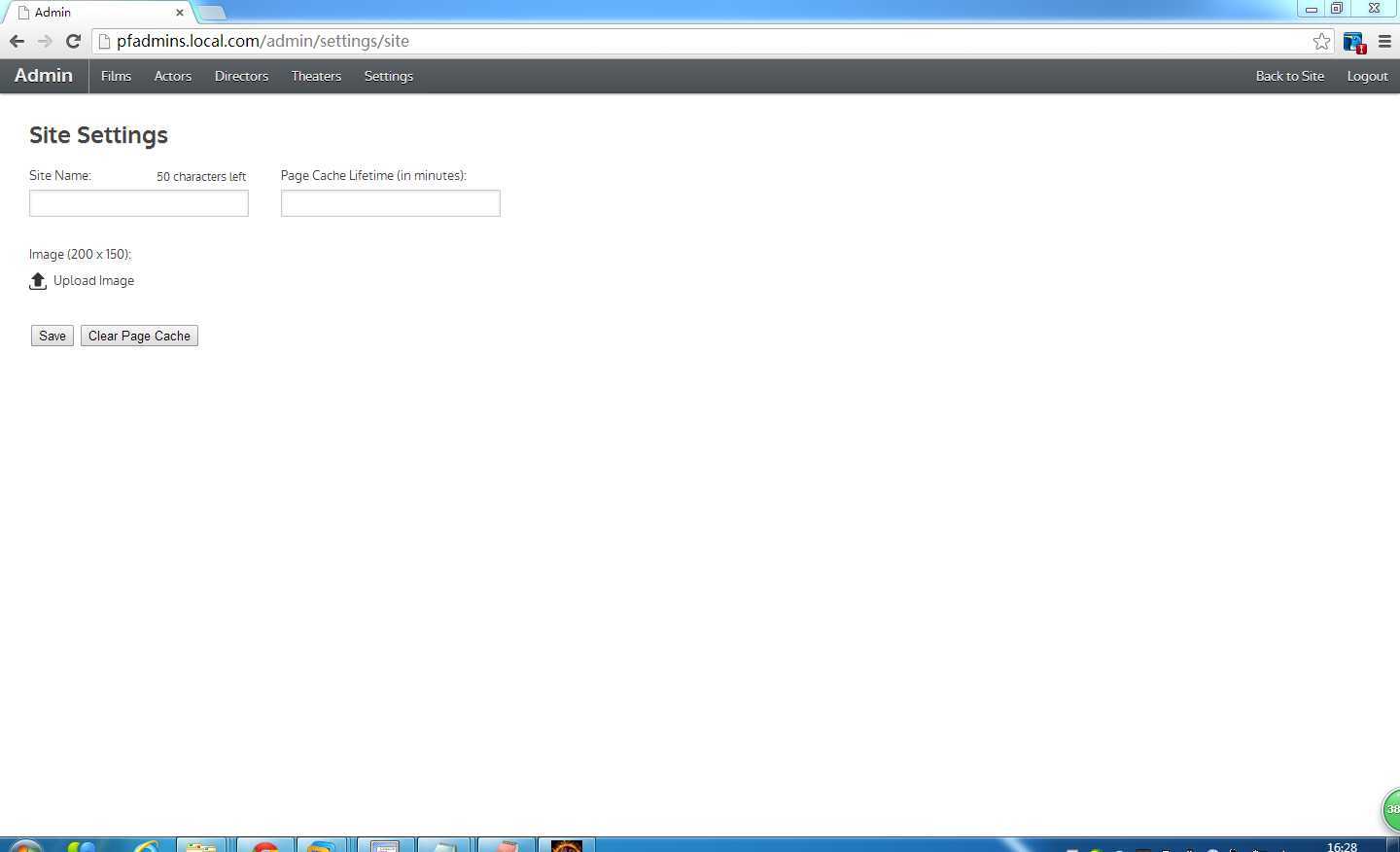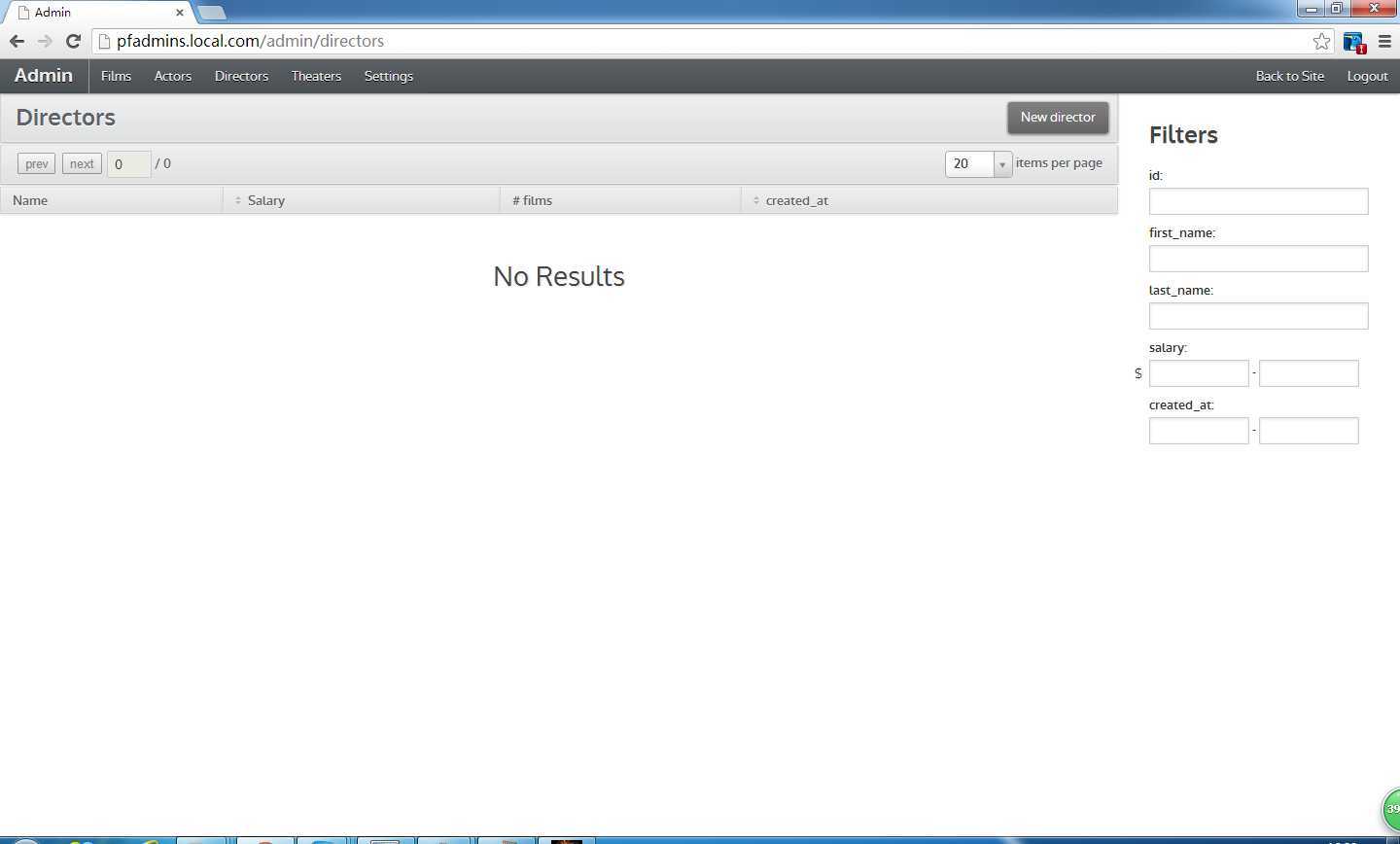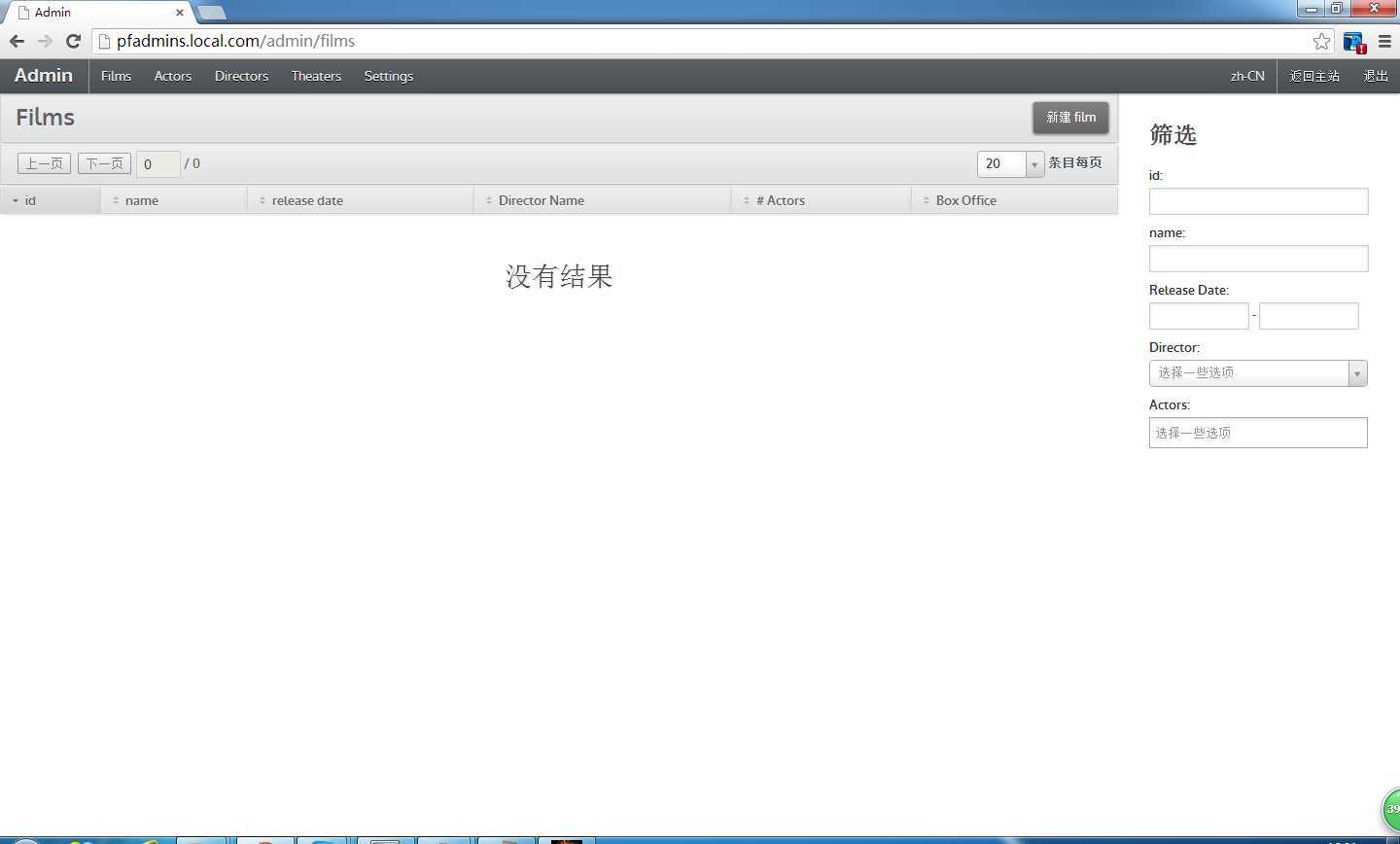标签:des style blog http color os io ar for
前几天我看了一下zend framework 2的一些官方文档,也找了一些例子,可惜所有的资料少之甚少。于是我就开始去找这国外用的比较流行的PHP框架laravel,希望能够找到其合适的例子,而且我本就打算写一套后台管理系统,却正好发现了其扩展的包。Laravel-Administrator后台扩展包,提供了基本上通用的界面以及数据操作的例子,我们再也不需要自己去找模板了,特别在这个html5开始盛行的时候,一步步苦苦摸索实在太费时费力。做过后台的朋友不妨看看,这可以使你的工作更快快速和方便。
自从vim有统一的插件管理工具pathogen后,估摸着PHP的爱好者才想出了这么一个主意,统一的(依赖)管理器,开源插件进行统一管理也的确势在必行,不说废话了,首先看看怎么安装这个东西吧。
curl -s http://getcomposer.org/installer| php && mv composer.phar /usr/sbin/composer
一条命令就帮你搭建好了基本的架构,是不是很方便呢?
composer create-project laravel/laravel your-project-name #记得改成你的项目名称
cd your-project-name && vim composer.json #进入项目目录并编辑composer.json,把"frozennode/administrator": "dev-master"加入到"require"下
以下为最终的配置:
{ "name": "laravel/laravel", "description": "The Laravel Framework.", "keywords": ["framework", "laravel"], "license": "MIT", "require": { "laravel/framework": "4.2.*", "frozennode/administrator": "dev-master" }, "autoload": { "classmap": [ "app/commands", "app/controllers", "app/models", "app/database/migrations", "app/database/seeds", "app/tests/TestCase.php" ] }, "scripts": { "post-install-cmd": [ "php artisan clear-compiled", "php artisan optimize" ], "post-update-cmd": [ "php artisan clear-compiled", "php artisan optimize" ], "post-create-project-cmd": [ "php artisan key:generate" ] }, "config": { "preferred-install": "dist" }, "minimum-stability": "stable" }
vim app/config/app.php #找到数组providers,并在最后加入‘Frozennode\Administrator\AdministratorServiceProvider‘,
以下为最终的配置:
<?php return array( /* |-------------------------------------------------------------------------- | Application Debug Mode |-------------------------------------------------------------------------- | | When your application is in debug mode, detailed error messages with | stack traces will be shown on every error that occurs within your | application. If disabled, a simple generic error page is shown. | */ ‘debug‘ => true, /* |-------------------------------------------------------------------------- | Application URL |-------------------------------------------------------------------------- | | This URL is used by the console to properly generate URLs when using | the Artisan command line tool. You should set this to the root of | your application so that it is used when running Artisan tasks. | */ ‘url‘ => ‘http://pfadmins.local.com‘, /* |-------------------------------------------------------------------------- | Application Timezone |-------------------------------------------------------------------------- | | Here you may specify the default timezone for your application, which | will be used by the PHP date and date-time functions. We have gone | ahead and set this to a sensible default for you out of the box. | */ ‘timezone‘ => ‘UTC‘, /* |-------------------------------------------------------------------------- | Application Locale Configuration |-------------------------------------------------------------------------- | | The application locale determines the default locale that will be used | by the translation service provider. You are free to set this value | to any of the locales which will be supported by the application. | */ ‘locale‘ => ‘en‘, /* |-------------------------------------------------------------------------- | Application Fallback Locale |-------------------------------------------------------------------------- | | The fallback locale determines the locale to use when the current one | is not available. You may change the value to correspond to any of | the language folders that are provided through your application. | */ ‘fallback_locale‘ => ‘en‘, /* |-------------------------------------------------------------------------- | Encryption Key |-------------------------------------------------------------------------- | | This key is used by the Illuminate encrypter service and should be set | to a random, 32 character string, otherwise these encrypted strings | will not be safe. Please do this before deploying an application! | */ ‘key‘ => ‘4g1RkrnrYg1UdkEHxUV3p8UBAlnTmWiZ‘, ‘cipher‘ => MCRYPT_RIJNDAEL_128, /* |-------------------------------------------------------------------------- | Autoloaded Service Providers |-------------------------------------------------------------------------- | | The service providers listed here will be automatically loaded on the | request to your application. Feel free to add your own services to | this array to grant expanded functionality to your applications. | */ ‘providers‘ => array( ‘Illuminate\Foundation\Providers\ArtisanServiceProvider‘, ‘Illuminate\Auth\AuthServiceProvider‘, ‘Illuminate\Cache\CacheServiceProvider‘, ‘Illuminate\Session\CommandsServiceProvider‘, ‘Illuminate\Foundation\Providers\ConsoleSupportServiceProvider‘, ‘Illuminate\Routing\ControllerServiceProvider‘, ‘Illuminate\Cookie\CookieServiceProvider‘, ‘Illuminate\Database\DatabaseServiceProvider‘, ‘Illuminate\Encryption\EncryptionServiceProvider‘, ‘Illuminate\Filesystem\FilesystemServiceProvider‘, ‘Illuminate\Hashing\HashServiceProvider‘, ‘Illuminate\Html\HtmlServiceProvider‘, ‘Illuminate\Log\LogServiceProvider‘, ‘Illuminate\Mail\MailServiceProvider‘, ‘Illuminate\Database\MigrationServiceProvider‘, ‘Illuminate\Pagination\PaginationServiceProvider‘, ‘Illuminate\Queue\QueueServiceProvider‘, ‘Illuminate\Redis\RedisServiceProvider‘, ‘Illuminate\Remote\RemoteServiceProvider‘, ‘Illuminate\Auth\Reminders\ReminderServiceProvider‘, ‘Illuminate\Database\SeedServiceProvider‘, ‘Illuminate\Session\SessionServiceProvider‘, ‘Illuminate\Translation\TranslationServiceProvider‘, ‘Illuminate\Validation\ValidationServiceProvider‘, ‘Illuminate\View\ViewServiceProvider‘, ‘Illuminate\Workbench\WorkbenchServiceProvider‘, ‘Frozennode\Administrator\AdministratorServiceProvider‘, ), /* |-------------------------------------------------------------------------- | Service Provider Manifest |-------------------------------------------------------------------------- | | The service provider manifest is used by Laravel to lazy load service | providers which are not needed for each request, as well to keep a | list of all of the services. Here, you may set its storage spot. | */ ‘manifest‘ => storage_path().‘/meta‘, /* |-------------------------------------------------------------------------- | Class Aliases |-------------------------------------------------------------------------- | | This array of class aliases will be registered when this application | is started. However, feel free to register as many as you wish as | the aliases are "lazy" loaded so they don‘t hinder performance. | */ ‘aliases‘ => array( ‘App‘ => ‘Illuminate\Support\Facades\App‘, ‘Artisan‘ => ‘Illuminate\Support\Facades\Artisan‘, ‘Auth‘ => ‘Illuminate\Support\Facades\Auth‘, ‘Blade‘ => ‘Illuminate\Support\Facades\Blade‘, ‘Cache‘ => ‘Illuminate\Support\Facades\Cache‘, ‘ClassLoader‘ => ‘Illuminate\Support\ClassLoader‘, ‘Config‘ => ‘Illuminate\Support\Facades\Config‘, ‘Controller‘ => ‘Illuminate\Routing\Controller‘, ‘Cookie‘ => ‘Illuminate\Support\Facades\Cookie‘, ‘Crypt‘ => ‘Illuminate\Support\Facades\Crypt‘, ‘DB‘ => ‘Illuminate\Support\Facades\DB‘, ‘Eloquent‘ => ‘Illuminate\Database\Eloquent\Model‘, ‘Event‘ => ‘Illuminate\Support\Facades\Event‘, ‘File‘ => ‘Illuminate\Support\Facades\File‘, ‘Form‘ => ‘Illuminate\Support\Facades\Form‘, ‘Hash‘ => ‘Illuminate\Support\Facades\Hash‘, ‘HTML‘ => ‘Illuminate\Support\Facades\HTML‘, ‘Input‘ => ‘Illuminate\Support\Facades\Input‘, ‘Lang‘ => ‘Illuminate\Support\Facades\Lang‘, ‘Log‘ => ‘Illuminate\Support\Facades\Log‘, ‘Mail‘ => ‘Illuminate\Support\Facades\Mail‘, ‘Paginator‘ => ‘Illuminate\Support\Facades\Paginator‘, ‘Password‘ => ‘Illuminate\Support\Facades\Password‘, ‘Queue‘ => ‘Illuminate\Support\Facades\Queue‘, ‘Redirect‘ => ‘Illuminate\Support\Facades\Redirect‘, ‘Redis‘ => ‘Illuminate\Support\Facades\Redis‘, ‘Request‘ => ‘Illuminate\Support\Facades\Request‘, ‘Response‘ => ‘Illuminate\Support\Facades\Response‘, ‘Route‘ => ‘Illuminate\Support\Facades\Route‘, ‘Schema‘ => ‘Illuminate\Support\Facades\Schema‘, ‘Seeder‘ => ‘Illuminate\Database\Seeder‘, ‘Session‘ => ‘Illuminate\Support\Facades\Session‘, ‘SoftDeletingTrait‘ => ‘Illuminate\Database\Eloquent\SoftDeletingTrait‘, ‘SSH‘ => ‘Illuminate\Support\Facades\SSH‘, ‘Str‘ => ‘Illuminate\Support\Str‘, ‘URL‘ => ‘Illuminate\Support\Facades\URL‘, ‘Validator‘ => ‘Illuminate\Support\Facades\Validator‘, ‘View‘ => ‘Illuminate\Support\Facades\View‘, ), );
php artisan config:publish frozennode/administrator #生成配置 vim app/config/packages/frozennode/administrator/administrator.php #你可以编辑此文件配置后台参数
如果没有示例我们也不知道如何开始,那么就让我们看看这个插件包所给出的例子吧。
cd ../ #退到工作目录 git clone https://github.com/FrozenNode/Laravel-Administrator #下载插件 cp Laravel-Administrator/examples/app/config/packages/frozennode/administrator/administrator.php your-project-name/app/config/packages/frozennode/administrator/ cp Laravel-Administrator/examples/app/config/administrator your-project-name/app/config/ -r cp Laravel-Administrator/examples/app/models your-project-name/app/ -r cp Laravel-Administrator/examples/app/database/migrations/* your-project-name/app/database/migrations/ mkdir -p your-project-name/public/packages/frozennode/administrator cp Laravel-Administrator/public/* your-project-name/public/packages/frozennode/administrator/ -r
#创建数据库 #首先根据你数据库的配置创建出你需要的数据,这里以mysql为例 cd your-project-name # 进入你的项目目录 vim app/config/database.php
以下为我的配置:
<?php return array( /* |-------------------------------------------------------------------------- | PDO Fetch Style |-------------------------------------------------------------------------- | | By default, database results will be returned as instances of the PHP | stdClass object; however, you may desire to retrieve records in an | array format for simplicity. Here you can tweak the fetch style. | */ ‘fetch‘ => PDO::FETCH_CLASS, /* |-------------------------------------------------------------------------- | Default Database Connection Name |-------------------------------------------------------------------------- | | Here you may specify which of the database connections below you wish | to use as your default connection for all database work. Of course | you may use many connections at once using the Database library. | */ ‘default‘ => ‘mysql‘, /* |-------------------------------------------------------------------------- | Database Connections |-------------------------------------------------------------------------- | | Here are each of the database connections setup for your application. | Of course, examples of configuring each database platform that is | supported by Laravel is shown below to make development simple. | | | All database work in Laravel is done through the PHP PDO facilities | so make sure you have the driver for your particular database of | choice installed on your machine before you begin development. | */ ‘connections‘ => array( ‘sqlite‘ => array( ‘driver‘ => ‘sqlite‘, ‘database‘ => __DIR__.‘/../database/production.sqlite‘, ‘prefix‘ => ‘‘, ), ‘mysql‘ => array( ‘driver‘ => ‘mysql‘, ‘host‘ => ‘localhost‘, ‘database‘ => ‘pf_admindb‘, ‘username‘ => ‘root‘, ‘password‘ => ‘mysql‘, ‘charset‘ => ‘utf8‘, ‘collation‘ => ‘utf8_unicode_ci‘, ‘prefix‘ => ‘‘, ), ‘pgsql‘ => array( ‘driver‘ => ‘pgsql‘, ‘host‘ => ‘localhost‘, ‘database‘ => ‘forge‘, ‘username‘ => ‘forge‘, ‘password‘ => ‘‘, ‘charset‘ => ‘utf8‘, ‘prefix‘ => ‘‘, ‘schema‘ => ‘public‘, ), ‘sqlsrv‘ => array( ‘driver‘ => ‘sqlsrv‘, ‘host‘ => ‘localhost‘, ‘database‘ => ‘database‘, ‘username‘ => ‘root‘, ‘password‘ => ‘‘, ‘prefix‘ => ‘‘, ), ), /* |-------------------------------------------------------------------------- | Migration Repository Table |-------------------------------------------------------------------------- | | This table keeps track of all the migrations that have already run for | your application. Using this information, we can determine which of | the migrations on disk haven‘t actually been run in the database. | */ ‘migrations‘ => ‘migrations‘, /* |-------------------------------------------------------------------------- | Redis Databases |-------------------------------------------------------------------------- | | Redis is an open source, fast, and advanced key-value store that also | provides a richer set of commands than a typical key-value systems | such as APC or Memcached. Laravel makes it easy to dig right in. | */ ‘redis‘ => array( ‘cluster‘ => false, ‘default‘ => array( ‘host‘ => ‘127.0.0.1‘, ‘port‘ => 6379, ‘database‘ => 0, ), ), );
保证数据库用户、密码、IP、端口正确的情况下,还需保证你的数据库存在后再执行以下命令。
php artisan migrate:install && php artisan migrate # 创建数据库及表 #以下是创建生成数据库表的一些命令,了解即可 #php artisan migrate:make create_directors_table #php artisan migrate:make create_films_table #php artisan migrate:make create_box_office #php artisan migrate:make create_actors #php artisan migrate:make create_actors_films #php artisan migrate:make create_theaters #php artisan migrate:make create_films_theaters
上次说到配置zend framework 2的时候,特别讲到这个配置,而laravel配置是一模一样的。
server { listen 80; server_name zf2.local.com; #域名 root /data/www/zf2/public; #你的网站目录,即项目目录记得加上public,否则访问方法不同 index index.php; #charset utf-8; location ~* \.(js|ico|gif|jpg|png|css|jpeg|swf)$ { access_log off; expires 2d; } location / { if (!-f $request_filename) { rewrite ^(.+)$ /index.php?$1& last; } } location ~ \.php$ { #root /var/www/html/public; fastcgi_pass 127.0.0.1:9000; #如果你的php-fpm的监听端口不是这个,请设置 fastcgi_index index.php; fastcgi_param SCRIPT_FILENAME $document_root$fastcgi_script_name; include fastcgi_params; } # deny access to .htaccess files, if Apache’s document root # concurs with nginx’s one # location ~ /\.ht { deny all; } }
将服务器IP与你的域名绑定,开始浏览,我这里的地址为http://pfadmins.local.com/admin。一定要加上admin,因为后台的url就在admin,当然你可以配置。



laravel administrator 一款通用的后台插件(PHP框架扩展)
标签:des style blog http color os io ar for
原文地址:http://www.cnblogs.com/lianyue/p/3951735.html